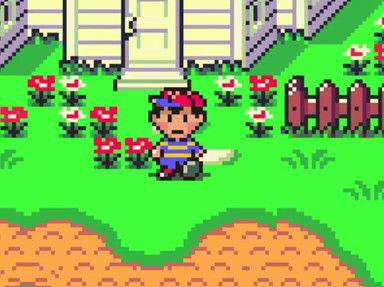Quiz Answer Key and Fun Facts
1. You know you're in a hostile land when even the local flora has it in for you! As you slog through the jungle-like land of Deep Darkness, beware of this exotic plant that lurks in the murky water. Its Japanese name translates to "Devil Rafflesia."
2. Down deep in the earth, in the Lost Underworld, dinosaurs still roam. And in the caves nearby, you might meet a goofy-looking but deadly ... blob. Its Japanese name means "Hotly Burning Enemy."
3. Here's a quick quiz: In "EarthBound," what character other than Mr. Saturn would be likely to go "boing"? Well, in Onett, use your imagination and find out. This jerk will try to ambush you. When he topples over, it's your chance to topple him. His name in Japanese translates to "Rebound Kid."
4. Rumor has it that this character hangs out with another "EarthBound" fiend, the Mystical Record. Anyway, found in Winters on the return visit, this dizzying character is often assisted by tough cohorts. Its Japanese name, when translated, is an an onomotapeia: "Spiiiiiiiin."
5. What the heck is this floating, glowing thing? One of the many enigmatic enemies, and another creature of the Fire Springs, this enemy can cause a ghostly entity to possess one of your party members. The Japanese name means "Cursed Annoyance."
6. Onett is far from the only town that has youthful troublemakers -- and this character even likes to go clubbing! He shows up in Winters. If Jeff encounters him one-on-one, it'll be a tough fight. In Japanese, his name means "Bigfoot."
7. There's a savage beast -- actually, FIVE of them -- that lurks in a cavernous area beneath the Dusty Dunes Desert. If you can avoid getting mauled and succeed at quashing this quagmire quintet, you just might get a handsome reward. This enemy's name in Japanese means "Hole Master."
8. Beware of enemies that can cause amnesia -- especially in Moonside, where it's all too easy to forget who you are, what you're doing or when you're doing it! One insidious Moonsidian monster looks familiar, but never mind that -- your persistence will pay off. Its Japanese name translates to "Lost Memory."
9. Yet another bizarre fire-borne monster, this humanoid being comes from the Fire Spring in the Lost Underworld. His entire body (save for his head) seems to be wrapped in strange purple flames. In Japanese, his name translates to "PK Man - Superior."
10. Some monsters only fight solo, and this one is particularly unnerving -- even if it IS just two eyes and a mouth. Appearing at the very last area of the game, the Cave of the Past, this almost inexplicable entity will try to bite you with its disembodied fangs. In Japanese, its name translates to "Hermit Devil."
Source: Author
MrNobody97
This quiz was reviewed by FunTrivia editor
kyleisalive before going online.
Any errors found in FunTrivia content are routinely corrected through our feedback system.
